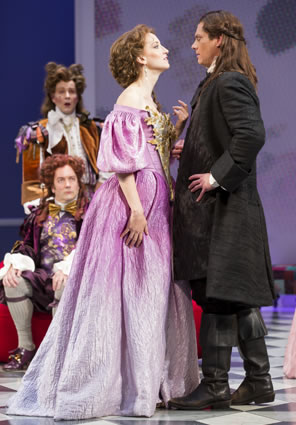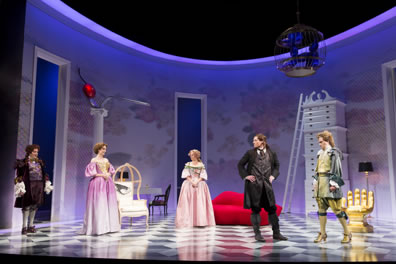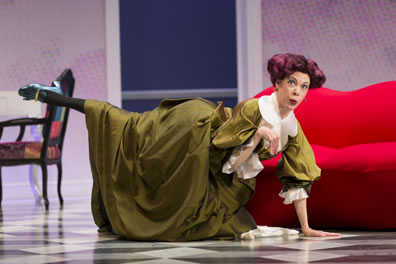The School for Lies
A Schooling in Truth
By David Ives (adapted from Molière's Le Misanthrope)
Shakespeare Theatre Company, Lansburgh Theatre, Washington, D.C.
Monday, June 5, 2017, H–7&9 (left stalls)
Directed by Michael Kahn
When I reviewed a David Ives–scripted play the last time, I wrote the whole darn thing in prose-structured rhyme. Not doing that again.

Celimene (Victoria Frings) confronts Frank (Gregory Wooddell) as two of Celimene's suitors, Clitander (Cameron Folmar, standing) and Acaste (Liam Craig) watch in the Shakespeare Theatre Company's production of The School for Lies by David Ives. Photo by Scott Suchman, Shakespeare Theatre Company.
The thing is, it's hard for me to adequately describe the whole body-and-mind experience of watching an Ives play cast and directed by Michael Kahn, artistic director of the Shakespeare Theatre Company (STC), which now has staged four such collaborative adaptations of French classic fare. The first, Pierre Corneille's The Liar in 2010, is still among the top five of my all-time favorite non-Shakespeare theater experiences. After Ives' and Kahn's similar efforts with Jean-Francois Regnard's The Heir Apparent in 2011 and Alexis Piron's The Metromaniacs in 2015, now comes this current production of The School for Lies, Ives' retooling of his own adaptation of Molière's Le Misanthrope. In terms of this particularly Ivesian idiom, The School for Lies continues a downward trend in quality, but to say each subsequent Ives-adapted/Kahn-directed product doesn't quite reach the heights of The Liar is to note that the Himalayan peaks of Kangchenjunga, Lhotse, and Makalu are a few hundred meters short of Everest. While not reaching the highest summit, like its Ives predecessors at STC's Lansburgh Theatre, The School for Lies attains breathless heights of comic theater.
Heck, just reading Ives' program notes for this production will have you LOLing even before the play begins. Six years after his "translaptation" (a hybrid translation and adaptation) of Le Misanthrope for New York's Classic Stage Company, "Michael [Kahn] called to tell me he'd be directing The School for Lies at STC, and I said it seemed a great idea," Ives writes. "Then, with odd emphasis at the end of our conversation, Michael added, 'You might want to look at the play.' Now, those are dark, demoralizing words for any playwright. Look at the play? Look back at The School for Lies, which was finished and perfect, sublime, if not immortal? Then, hélas, I looked at the play. By page three I had my pencil in hand and was crossing out long passages of perfect, sublime, immortal dialogue. But that's the thing about the theater: it's a school for truth."
That last point pings off the theme of both Molière's play and Ives' translaptation. "Society is nothing but a school for lies," the titular misanthrope of Molière's play says in Ives' play, and though he's speaking generically of both social decorum and slandering gossip, he also makes direct reference to "this city," i.e., Washington, D.C. There's irony in Trump & Company taking issue with the depiction of the president in the Public Theater's Free Shakespeare in the Park production of William Shakespeare's Julius Caesar up in New York when just down the road from both the White House and Congress, this production takes direct stabs at the pervading culture of mendacity in this city. (Or maybe not so ironic: Molière wrote his original satirical stab at the Parisian aristocracy to be performed before King Louis XIV.)
Being only vaguely familiar with Le Misanthrope and having not seen the original staging of The School for Lies, I can't speak to how much the STC product departs from its antecedents. Clearly, though, current events and conditions have been worked into the script, most notably in a prologue spoken by Philinte (Cody Nickell) explaining the premise for translaptating Molière, whom Philinte describes as a theatrical "top mensch: too bad for us he wrote his plays in French." But, to "serve Molière, we'll do our own damned version in English."
This prologue establishes the premise that The School for Lies is more than a translaptation of Molière's text: It's a hybrid of Molière's mid-17th century French bearings and commedia dell'arte influences and Ives' early 21st century American sensitivities and sitcom influences. This cultural conjugation is visually represented in Murell Horton's gorgeously detailed Sun King society costumes and wigs that the actors wear on a kitschy set designed by Alexander Dodge featuring a stool that looks like a gold hand, a sofa that looks like red lips, a domed high-back chair with a long-lashed eye in the stitchery, a pillar topped with a bent spoon holding a cherry, a 16-drawer-high white dresser with a ladder perched against it, and a cage hanging from the ceiling containing a dachshund made of purple balloons.
Although Ives generally keeps Molière's characters and circumstances, he does reshape the original play's plot, starting with renaming the title character, Alceste, as Frank (if, for no other reason, it provides some delightful rhyming humor and punning, though there is a more specific reason weaving through the plot for the name change). But as is his wont in all of his French adaptations, Ives adds more layers to the characters' existence, creating multiple alternate realities for both the on-stage personnel and the audience to navigate to surprise endings. I actually saw this play's surprise ending coming, long before Frank dons the eyewear that reveals his character's extreme case of hyperopia (physically as well as intellectually). I didn't see the other surprise endings coming, however, despite one deriving from an Ives trope of installing hitherto unknown blood relatives into the action and forcing an actor to play both parts—in this instance, Michael Glenn playing Basque, Frank's shaggy valet, and the fastidious-to-frustrated servant Dubois (I didn't see it coming because I didn't recognize Glenn in both parts).
Where Ives shines most is in his dialogue, a hybrid of Molièrean characters using contemporary vernacular while speaking in rhyming couplets. Although the comedy delivered via the rhyming construct in The School for Lies is not as sharp as Ives accomplishes in his earlier works, he yet demonstrates his singular skills in a couple of particular passages. The young widow Celimene (Victoria Frings) gossips about a couple of her coterie's social acquaintances, mimicking one in hip-hop rap and the other in a Valley Girl-cum-Simple Life lexicon—yet, rhyming still. Later, Celimene engages in a conversation with the "moral pillar" Arsinoé (Veanne Cox, whose prim ways can kill, using the comic sense of that word) in which they label each other with more synonyms for slut than a Facebook catfight can muster. This interchange is delivered with deliberate attention to the etiquette of social manners and in the service of offering friendly advice—and rhyming, too.


Shakespeare Theatre Company's production of The School for Lies, David Ives' "translaptation" of Molière's Le Misanthrope, is a hybrid of veracity and absurdity in the visual design and in the acting. Top, from left, Acaste (Liam Craig), Celimene (Victoria Frings), Eliante (Dorea Schmidt), Frank (Gregory Wooddell), and Philinte (Cody Nickell) in costumes by Murell Horton on a set by Alexander Dodge. Above, Arsinoé (Veanne Cox) remains a "moral pillar" even as she acts like a dog. Photos by Scott Suchman, Shakespeare Theatre Company.
Effectively carrying out such passages requires actors who not only exhibit skill in turning rhyming couplets into smooth conversation but who also have the confidence to play the most absurd of situations as believable drama. That is where Kahn's impact on these Ives outings comes to the fore, casting superb talent and forging ensemble mastery of the script's clickety-click-click-clickatillity-click pacing. A notable hallmark of these Ives productions is how the actors deliver not only silly jokes in rhyming couplets but obvious character flaws with unflinching dignity. This production doesn't uniformly achieve that standard—a couple of actors indulge in mugging tendancies to sell their jokes or reactions—but for the most part this cast exhibits the sublime skillset of stoic absurdity that Frings and Cox display in their testy tête-à-tête.
That skillset is a mainstay in Gregory Wooddell's portrayal of Frank, the misanthrope at the center of the plot who becomes smitten with Celimene despite his nature ("You're so eccentric," he's told; "I'm authentic," he replies), and vice versa, despite her nature to disdain such an absolutist angry young man. No matter his mood and motives and the bizarre turns of events thrown his way, Wooddell's Frank maintains a sharp fervency in manner and line delivery. And what incredible chemistry he has with Frings, even when her Celimene is nowhere near Frank. It's one of those few times when my exotropia comes in handy, watching the two actors playing off each other even when they are on opposite sides of the stage. When they clasp, their love radiates through their attempts to resist each other.
The plot's secondary couple of Eliante (Celimene's cousin) and Philinte (Frank's friend) also feature standout performances. Dorea Schmidt's Eliante is sweetly puritan as she defends Frank's misanthropic ways and demurely attends to Philinte's clumsy courting. However, when, through a series of misunderstandings, she believes Frank to be in love with her, the mouse that is Eliante turns into a sex-crazed leopard, to the point that Frank can't help falling in love with her, too (after all, she has him in a schoolboy pin; what else would he do?). Nickell gives an effortlessly exquisite performance as Philinte, the actor's finely honed craftsmanship sculpting a character who is genial and generous to all comers but just a tad slow in wit—that tad measured in Nickell's impeccable timing. He seems to become a mere butt of a running joke when planted rumors that he is a cross-dresser leads him to cross-dressing, but in one of those typically quirky Ives climaxes, Philinte comes out of nowhere (in the script—he's there on the stage the entire time) to save the day.
This is just the first of a series of bizarre but somehow plausible twists in the last few minutes of the 90-minute play through which true identities and honest feelings are revealed. The characters emerge from their fogs of alternative realities to reach the place where each belongs, in their hearts and their physical beings, and we've reached the summit of a delightful worldview. What a fun climb it's been.
Eric Minton
June 15, 2017
Comment: e-mail editorial@shakespeareances.com
Start a discussion in the Bardroom



 Find additional Shakespeareances
Find additional Shakespeareances